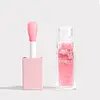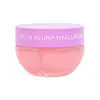What's inside
What's inside
 Key Ingredients
Key Ingredients

 Benefits
Benefits

 Concerns
Concerns

No concerns
 Ingredients Side-by-side
Ingredients Side-by-side

Hydrogenated Polyisobutene
EmollientIsononyl Isononanoate
EmollientEthylene/Propylene/Styrene Copolymer
Diisostearyl Malate
EmollientPolybutene
Aroma
BHT
AntioxidantButylene/Ethylene/Styrene Copolymer
C20-24 Olefin
Skin ConditioningCaprylic/Capric Triglyceride
MaskingHydroxymethoxyphenyl Propylmethylmethoxybenzofuran
Skin ConditioningPassiflora Edulis Seed Oil
EmollientPentaerythrityl Tetra-Di-T-Butyl Hydroxyhydrocinnamate
AntioxidantRubus Idaeus Leaf Extract
Skin ConditioningRubus Idaeus Seed Oil
EmollientSynthetic Fluorphlogopite
Tocopherol
AntioxidantTocopheryl Acetate
AntioxidantTriethoxycaprylylsilane
CI 15850
Cosmetic ColorantHydrogenated Polyisobutene, Isononyl Isononanoate, Ethylene/Propylene/Styrene Copolymer, Diisostearyl Malate, Polybutene, Aroma, BHT, Butylene/Ethylene/Styrene Copolymer, C20-24 Olefin, Caprylic/Capric Triglyceride, Hydroxymethoxyphenyl Propylmethylmethoxybenzofuran, Passiflora Edulis Seed Oil, Pentaerythrityl Tetra-Di-T-Butyl Hydroxyhydrocinnamate, Rubus Idaeus Leaf Extract, Rubus Idaeus Seed Oil, Synthetic Fluorphlogopite, Tocopherol, Tocopheryl Acetate, Triethoxycaprylylsilane, CI 15850
Hydrogenated Polyisobutene
EmollientPolybutene
Bis-Behenyl/Isostearyl/Phytosteryl Dimer Dilinoleyl Dimer Dilinoleate
EmollientDiisostearyl Malate
EmollientSynthetic Wax
AbrasiveEthylene/Propylene/Styrene Copolymer
Sucrose Tetrastearate Triacetate
EmollientEuphorbia Cerifera Cera
AstringentTribehenin
EmollientTrihydroxystearin
Skin ConditioningSodium Hyaluronate
HumectantRubus Idaeus Leaf Extract
Skin ConditioningTerminalia Ferdinandiana Fruit Extract
AntioxidantPrunus Salicina Fruit Extract
AntioxidantGlycerin
HumectantTocopherol
AntioxidantGardenia Florida Fruit Extract
Skin ConditioningPentaerythrityl Tetra-Di-T-Butyl Hydroxyhydrocinnamate
AntioxidantRebaudioside A
Skin ConditioningCaprylic/Capric Triglyceride
MaskingPolyglyceryl-3 Polyricinoleate
EmulsifyingPolyglyceryl-2 Triisostearate
EmulsifyingPolyglyceryl-2 Diisostearate
EmulsifyingButylene/Ethylene/Styrene Copolymer
Dehydroacetic Acid
PreservativeWater
Skin ConditioningAroma
Hydrogenated Polyisobutene, Polybutene, Bis-Behenyl/Isostearyl/Phytosteryl Dimer Dilinoleyl Dimer Dilinoleate, Diisostearyl Malate, Synthetic Wax, Ethylene/Propylene/Styrene Copolymer, Sucrose Tetrastearate Triacetate, Euphorbia Cerifera Cera, Tribehenin, Trihydroxystearin, Sodium Hyaluronate, Rubus Idaeus Leaf Extract, Terminalia Ferdinandiana Fruit Extract, Prunus Salicina Fruit Extract, Glycerin, Tocopherol, Gardenia Florida Fruit Extract, Pentaerythrityl Tetra-Di-T-Butyl Hydroxyhydrocinnamate, Rebaudioside A, Caprylic/Capric Triglyceride, Polyglyceryl-3 Polyricinoleate, Polyglyceryl-2 Triisostearate, Polyglyceryl-2 Diisostearate, Butylene/Ethylene/Styrene Copolymer, Dehydroacetic Acid, Water, Aroma
 Reviews
Reviews

Ingredients Explained
These ingredients are found in both products.
Ingredients higher up in an ingredient list are typically present in a larger amount.
Aroma refers to an ingredient, or mixture of ingredients, that impart or mask a flavor.
The name is slightly confusing. This is because INCI associates aroma with flavor instead of smell.
Here is the official definition from the The International Cosmetic Ingredient Dictionary and Handbook:
“Aroma is a term for ingredient labeling used to identify that a product contains a material or combination of materials normally added to a cosmetic to produce or to mask a particular flavor.”
INCI shows the only purpose of aroma to be "flavouring".
However, due to regulation differences, some companies may use aroma in place of parfum.
In Canada, this ingredient only has to be listed in concentrations above 1%.
Learn more about AromaWe don't have a description for Butylene/Ethylene/Styrene Copolymer yet.
This ingredient is an emollient, solvent, and texture enhancer. It is considered a skin-softener by helping the skin prevent moisture loss.
It helps thicken a product's formula and makes it easier to spread by dissolving clumping compounds.
Caprylic Triglyceride is made by combining glycerin with coconut oil, forming a clear liquid.
While there is an assumption Caprylic Triglyceride can clog pores due to it being derived from coconut oil, there is no research supporting this.
Learn more about Caprylic/Capric TriglycerideDiisostearyl Malate is an emollient and most often used in lip products. It comes from isostearyl alcohol, a fatty acid, and malic acid, an AHA.
As an emollient, Diisostearyl Malate helps create a thin film on your skin to trap moisture in. This helps keep your skin soft and smooth.
We don't have a description for Ethylene/Propylene/Styrene Copolymer yet.
Hydrogenated Polyisobutene is a synthetic polymer. Polymers are compounds with high molecular weight. Hydrogenated Polyisobutene is an emollient and texture enhancer.
In one study, Hydrogenated Polyisobutene showed better skin hydration levels than Caprylic/Capric Triglyceride. As an emollient, it helps keep your skin soft and hydrated by trapping moisture in.
Hydrogenated Polyisobutene is often used as a mineral oil replacement.
Learn more about Hydrogenated PolyisobutenePentaerythrityl Tetra-Di-T-Butyl Hydroxyhydrocinnamate (long name, huh?) is a synthetic antioxidant.
It is used to help stabilize other antioxidants or prevent the color from changing in a product.
As an antioxidant, it helps fight free-radical molecules. Free-radical molecules are capable of damaging our cells and other genetic material. Thus, antioxidants may reduce the signs of aging.
This ingredient is oil-soluble.
Learn more about Pentaerythrityl Tetra-Di-T-Butyl HydroxyhydrocinnamatePolybutene is used to help control the viscosity of a product. This just means it helps adjusts the texture.
It is a polymer and does not get absorbed into the skin due to its large size.
Studies found this ingredient did not irritate skin in concentrations below 15%.
Learn more about PolybuteneWe don't have a description for Rubus Idaeus Leaf Extract yet.
Tocopherol (also known as Vitamin E) is a common antioxidant used to help protect the skin from free-radicals and strengthen the skin barrier. It's also fat soluble - this means our skin is great at absorbing it.
Vitamin E also helps keep your natural skin lipids healthy. Your lipid skin barrier naturally consists of lipids, ceramides, and fatty acids. Vitamin E offers extra protection for your skin’s lipid barrier, keeping your skin healthy and nourished.
Another benefit is a bit of UV protection. Vitamin E helps reduce the damage caused by UVB rays. (It should not replace your sunscreen). Combining it with Vitamin C can decrease sunburned cells and hyperpigmentation after UV exposure.
You might have noticed Vitamin E + C often paired together. This is because it is great at stabilizing Vitamin C. Using the two together helps increase the effectiveness of both ingredients.
There are often claims that Vitamin E can reduce/prevent scarring, but these claims haven't been confirmed by scientific research.
Learn more about Tocopherol